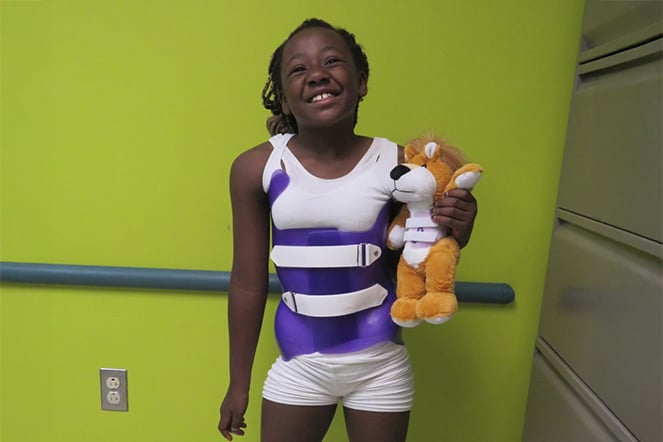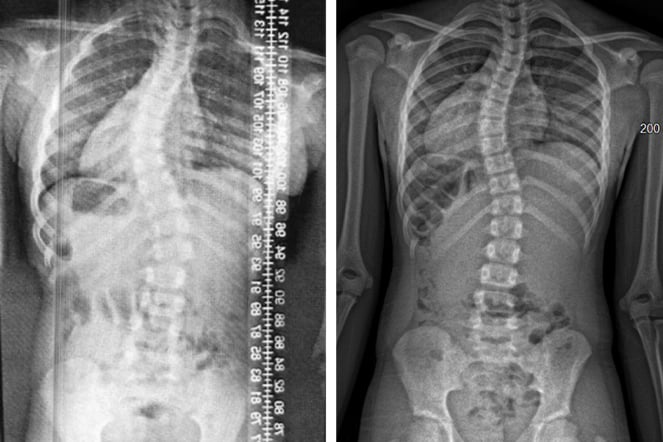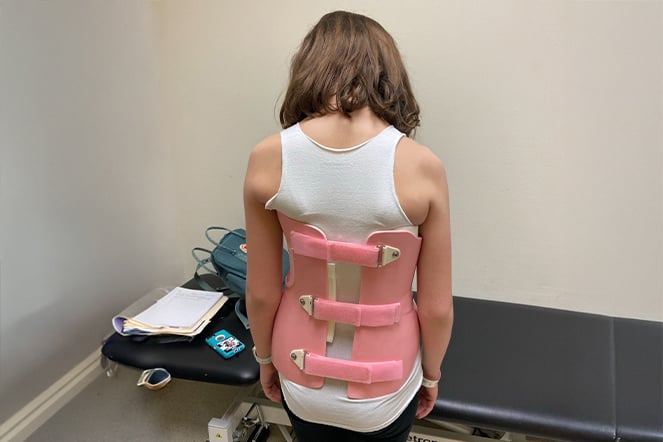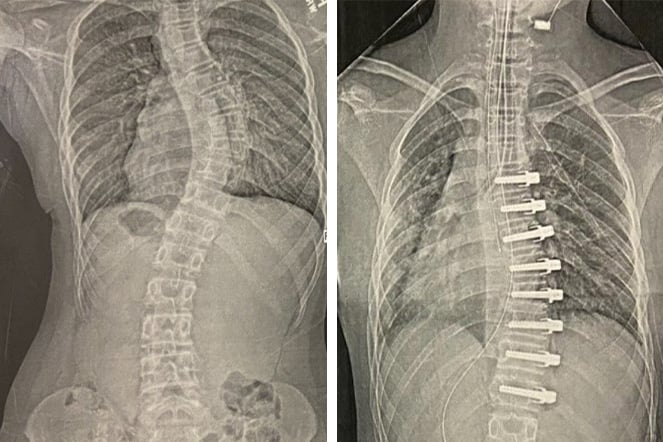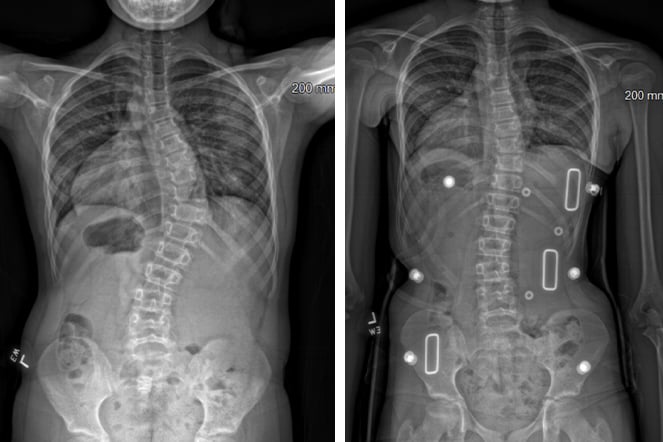Chloe
Chloe, Paciente Embajadora del Hospital Shriners para Niños de Erie, se realizó un chequeo pediátrico de rutina a los 12 años que derivó en un diagnóstico de escoliosis. Al revisarla, su pediatra notó una joroba en las costillas cuando se inclinó para tocarse los dedos de los pies y le pidió radiografías para confirmar la curvatura. La noticia dejó a Chloe ansiosa, insegura de cuán visible sería la curva para los demás y temerosa de que la cirugía fuera su única opción.
En aquel momento, nunca había oído hablar de usar un corsé para la escoliosis. Chloe comenzó el tratamiento con un corsé ortopédico, una adaptación que le resultó un reto tanto físico como emocional. “Me sentía un poco como una tortuga”, dijo, recordando aquellos momentos de movilidad reducida e incomodidad en la escuela. A pesar de su gran esfuerzo y el apoyo de los equipos de POPS de los Hospitales Shriners de Erie y de Filadelfia, el corsé no fue suficiente para evitar que la curva siguiera empeorando. Finalmente, la cirugía era el siguiente paso.
En 2021 Chloe se sometió a un procedimiento de anclaje del cuerpo vertebral (VBT, por sus siglas en inglés). El procedimiento estuvo a cargo del Dr. Joshua Pahys, MD, cirujano ortopédico pediátrico.
“Gracias a su determinación y esfuerzo, tuvo una recuperación satisfactoria y retomó todas sus actividades antes de lo previsto”, dijo Pahys. “Su historia es un ejemplo de lo bien que pueden salir adelante los niños incluso cuando se enfrentan a una cirugía”. Chloe se puso en contacto con otra paciente con escoliosis antes de la cirugía, y sus videollamadas la ayudaron a calmar sus nervios y sentirse más segura.
La recuperación de Chloe estuvo llena de pequeñas victorias. “Recuerdo cuando el Dr. Pahys me autorizó a volver a subirme a las montañas rusas, ¡lo celebré como una fiesta!”, dijo.
Chloe agradece a los equipos de atención del Hospital Shriners para Niños por ayudarla a sentirse empoderada y optimista. Hoy en día, tiene un gran interés en concienciar a la población, fomentar la detección temprana y romper el estigma que rodea a la escoliosis. “Nunca estás sola”, dijo, instando a las adolescentes recién diagnosticadas a que se pongan en contacto y conecten con otras personas. Su experiencia le enseñó fortaleza, paciencia y la importancia de la autodefensa. Ahora anima a otros a que también compartan sus historias.
Savannah
Savannah, Paciente Embajadora del Hospital Shriners para Niños de Erie, tuvo el diagnóstico de escoliosis años antes de que comenzara su proceso de atención médica. Su médico de cabecera le diagnosticó escoliosis, pero no le mandó a hacerse una radiografía en ese momento. No fue hasta que Savannah comenzó a tener dificultades para respirar en la escuela que su madre, Tracy, decidió programar una visita con otro médico, quien ordenó una radiografía de tórax. Los resultados revelaron que Savannah tenía una curvatura anormal en la columna vertebral. Sin dudarlo, Tracy cogió el teléfono y llamó al Hospital Shriners para Niños de Erie.
En Shriners, Savannah y su familia encontraron respuestas. Con la atención del Dr. Ozgur Dede, MD y Hannah Clark, MS, CPO, descubrieron que la curvatura espinal de Savannah medía 48 grados, lo que supera con creces la marca de 20 grados en la que se suele empezar a usar el corsé. “Debido a la gravedad de su curva, el equipo tuvo que plantear todas las opciones de tratamiento desde el principio”, dijo Hannah. “El uso de un corsé iba a ser el primer paso, entendiendo que si no resultaba efectivo, podría ser necesaria la cirugía”.
Desde el principio, la familia de Savanah dejó claro que la chica no estaba sola en su lucha. Sus padres, Tracy y Brad, transformaron la frustración y miedo que habían sentido al inicio en defensa y apoyo. La primera noche que Savannah recibió su aparato ortopédico, organizó una pijamada con sus amigas más cercanas. Savannah lució su aparato ortopédico, explicó a sus amigas por qué tenía que usarlo y respondió a todas sus preguntas mientras disfrutaba de otras actividades de la fiesta de pijamas.
Desde el diagnóstico, Savannah y sus padres han organizado eventos para recaudar fondos para Shriners Children's y han sido voluntarios de clubes locales de Shriners International. También han participado como invitados en entrevistas televisivas, recibieron una proclamación del gobernador de Pensilvania, Josh Shapiro, y actualmente están trabajando con la senadora estatal de Pensilvania, Michelle Brooks, para reducir la edad a partir de la cual las escuelas públicas realizan pruebas de detección de escoliosis.
Las historias de Abagail, Chloe y Savannah resaltan la naturaleza única de cada proceso de escoliosis y el papel crucial que desempeña la atención personalizada en cada etapa. La detección precoz es clave para el éxito del tratamiento, y a menudo marca la diferencia entre un tratamiento no invasivo y una intervención quirúrgica. Cuando las familias, las escuelas y los proveedores de atención médica están informados y preparados para reconocer los primeros signos, los niños tienen muchas más posibilidades de controlar su afección de manera eficaz con una mínima alteración de su vida diaria. Por eso, concienciar y promover la educación sobre la escoliosis es tan importante. Promover los exámenes de detección rutinarios, la atención informada y el diálogo abierto puede ayudar a garantizar que más niños sean diagnosticados a tiempo, reciban el apoyo que necesitan y estén capacitados para prosperar a lo largo de su vida.
